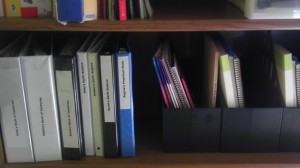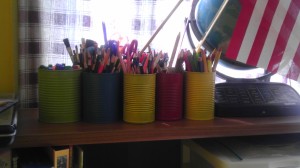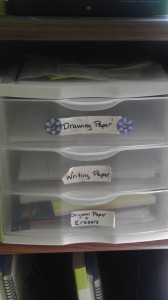Back to Homeschool Series – “Organizing Your Schoolwork”
August 22, 2013
Last time we talked about organizing your home library. Today, I want to chat a bit about how to organize your child’s schoolwork. There are many different ways you can do this, but I’m going to show you what works for my family.
This is our “School” shelf in the kitchen. I wish we had a dedicated school room, but unfortunately, our home doesn’t have the space for that. My goal is to have things easily within my children’s reach but without making our house look like a school room. I’ve settled for looking more like a library. 😉
I’ll start with the bottom shelf. Those two bins contain our science experiment kits from the Young Scientist Club. The kits are nice, but I’ll admit that we don’t use them as often as I would like. It is actually one of my goals this school year – hence their prominent appearance on our shelf. If they are out in the open, maybe we’ll actually use them.
 On the next shelf up, we have all our binders, notebooks, and workbooks. I try to keep our workbooks and spiral bound notebooks in the large plastic magazine holders. This makes it easy to see everything, and easy to put everything away. A couple of years ago we tried using bins to store these, but that ended up not working as well as the magazine files.
On the next shelf up, we have all our binders, notebooks, and workbooks. I try to keep our workbooks and spiral bound notebooks in the large plastic magazine holders. This makes it easy to see everything, and easy to put everything away. A couple of years ago we tried using bins to store these, but that ended up not working as well as the magazine files.
My school age children are all middle school age and up – the twins are beginning 6th grade this year and my oldest is beginning 9th grade. The way I organize their work is they each have a Book of Centuries where we place all of their history related work, as well as a science binder, where we organize their science lessons. You can learn more about how I use a Book of Centuries here. I like to start my children with a Book of Centuries binder in 6th grade and they continue with it through high school. I love using the binders with the clear sheet on the front and sides. My kids decorate a cover for their notebook, usually something related to the subject.
Here you can see Riley’s science notebook from last year (we studied Biology). By personalizing their notebooks, it’s easy to find their own book instead of arguing over which binder is which, and they always enjoy the task of drawing their covers.
Here is the inside of the binder – you can see I’ve placed dividers to help organize their work – timeline, vocabulary, sketches, experiments and writing. This is how Elemental Science has you set up a binder, but you can divide up the work like this for any program. It really does help to keep your child’s work neat and orderly – which is especially helpful if you need to put together a portfolio at the end of the school year. It also starts to teach them personal organizational skills which will help them for the rest or their life.
I set up a binder for my youngest – she’s only 4, so she doesn’t have any serious school work this year, but because she likes to be in the middle of the action. She now has a place to keep her “work” and will start to get the hang of the routine for when she is older. She also has a few workbooks I picked up for her at Walmart – nothing fancy, but something to do when she wants to work like her siblings. I plan on reading lots of picture books with her this year and work with her on writing her letters and numbers. At that age – my kids have enjoyed drawing pictures of what we read about, exploring nature and drawing what they see outside, doing LOTS of art projects and making up their own stories, which they dictate to me (and I then print them out and allow them to add illustrations). I may expand upon this later in it’s own blog post.
Back to the topic of organizing our schoolwork: for narration, dictation/copywork or anything else that doesn’t require either a workbook or notebooking pages, we use spiral bound notebooks – one per subject. I had tried keeping everything in binders, but having that many binders doesn’t fit well on a shelf, and the amount of loose paper we were burning through was obscene. I find that with a spiral bound notebook, they keep their work a bit neater, because they know it’s “permanent.” These notebooks fit neatly into the magazine cases.
The next shelf up is where I keep all the How to Draw books and other hands-on art resources. All of my kids LOVE to draw, so these books get used fairly regularly. Beside these books is a small 3-drawer bin where I keep paper. I need to replace the labels, but the top drawer is where I keep the drawing paper (just plain printer paper), the middle drawer is loose leaf lined paper, and the bottom drawer is full of origami paper, index cards, stickers, etc. It was supposed to also hold the erasers, but they ended up in a can on the top of the bookshelf.
 Which leads me to show you the top shelf – this is where the supplies live. Last summer I collected several tin cans and we spray painted them pretty colors. Each can holds either whiteboard markers, color pencils, writing pencils, scissors, pens, erasers, etc. It makes it so much easier to clean up or get out what we need – just grab a can and go.
Which leads me to show you the top shelf – this is where the supplies live. Last summer I collected several tin cans and we spray painted them pretty colors. Each can holds either whiteboard markers, color pencils, writing pencils, scissors, pens, erasers, etc. It makes it so much easier to clean up or get out what we need – just grab a can and go.
I’d like to share a little freebie with you here – because I’ve spent the entire morning putting together two Books of Centuries for my twins. I thought I’d share a helpful PDF for putting together your own. Just print the dates out on cardstock, cut them out and place them in the label space of 37 divider tabs.
Freebie: Download Book of Centuries Dates Here
So, that’s our school space. We have had this system in place for going on 3 years now, and it’s what has worked the best for us. I would love to see how you organize your children’s school work. Please feel free to share in the comments!
Check out our Current Full Grade Level Products Available for Purchase – Kindergarten – Grade 1 – Grade 2 – Grade 3 – Grade 4 – Grade 5 – Grade 6
Related Article(s):
- Back to Homeschool Series – “The Daily Routine”
- Back to Homeschool Series – “Organizing Your Schoolwork”
- Back to Homeschool Series – “Book Organization”




